If there is any country in the world that can build and/or buy its way out of a crisis, it’s Singapore. The wealthy city-state, which is now three-quarters vaccinated against Covid-19 and has re-opened, is keeping its eye on the long-term challenges of climate change.
Singapore’s climate change adaptation
Singapore’s CBD, along with a third of the country’s land, is less than five metres above sea level. Like the Netherlands, much of Singapore was formerly underwater before the “reclamation” of land from the sea.
So it is at obvious risk from sea-level rises, storm surges and flooding. Since 1980, the country’s average annual rainfall has also increased at an average rate of around 70mm per decade. Singapore experienced city-wide flash-flooding in April, when 90% of its monthly rainfall fell in 24 hours.
Two years ago, Singapore’s leader projected the country may spend over S$100 billion (US$72 billion) in climate change adaptation measures. These include raising land to 5m above sea level, in line with some of the worst predicted outcomes in the latest UN climate change report.
The city is building a network of canals to improve drainage. All new developments must have “detention tanks,” in which stormwater can be stored in order to moderate urban flooding. All of Singapore’s built-up coastline is being lined with concrete walls or stone embankments.
Strikingly, the construction taking place today is based on assessments first commissioned back in 2013. It goes to show just how far behind the eight-ball Australia is.
Can Sea-Walls Save Us From Sea-Level Rises?
Singapore’s largely seafront shore is one scenario, but Australia’s harbourfront Royal Navy-base-turned-capital cities are quite another. As studies from San Francisco Bay have shown, walling off one part of a harbour, bay or estuary simply pushes the problem somewhere else.
Sea-walls and levees in the wrong part of an estuary can actually increase overall damages by hundreds of millions of dollars. That’s according to a Scientific American report based on research by oceanography professor Michelle Hummel.
Yet this seems to be the approach many cities are taking. All along its east coast, US cities are looking at a $1-2 billion cost for sea-walls. The total cost, around $400 billion, has been compared to the US interstate highway system.

The alternative approach is to develop “living barriers,” like mangroves and wetlands. In some major storms, wetlands have proven to be far more resilient than sea-walls.
Either way, Australian governments need a major injection of initiative in the face of multiple, intersecting policy challenges over the coming decade.
Follow Christian on Twitter for more news updates.